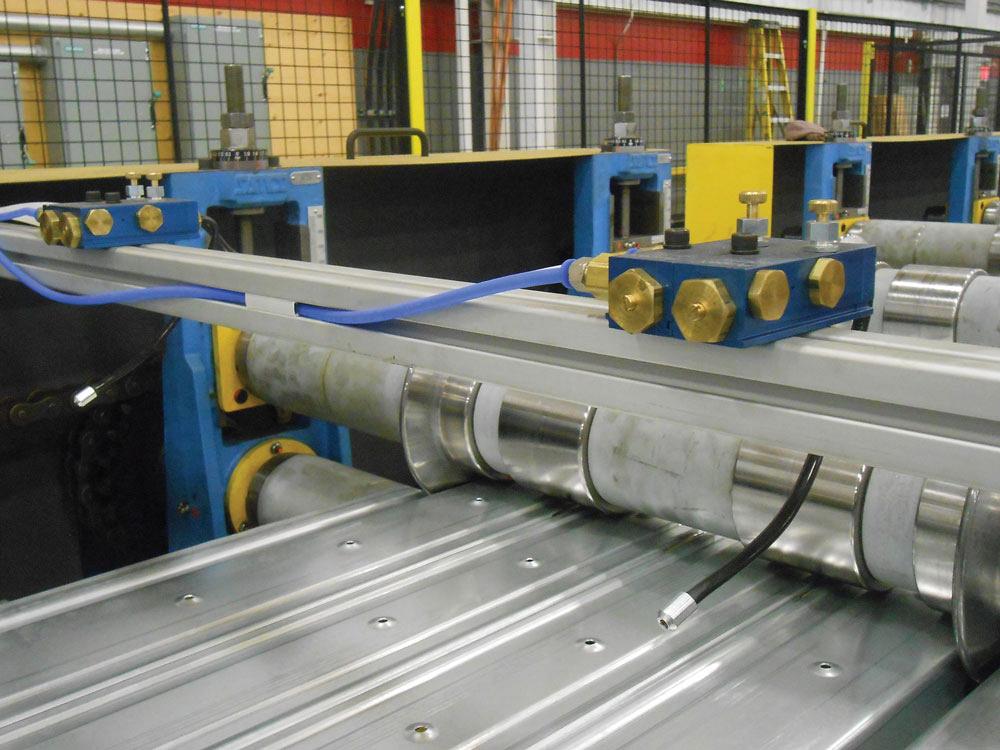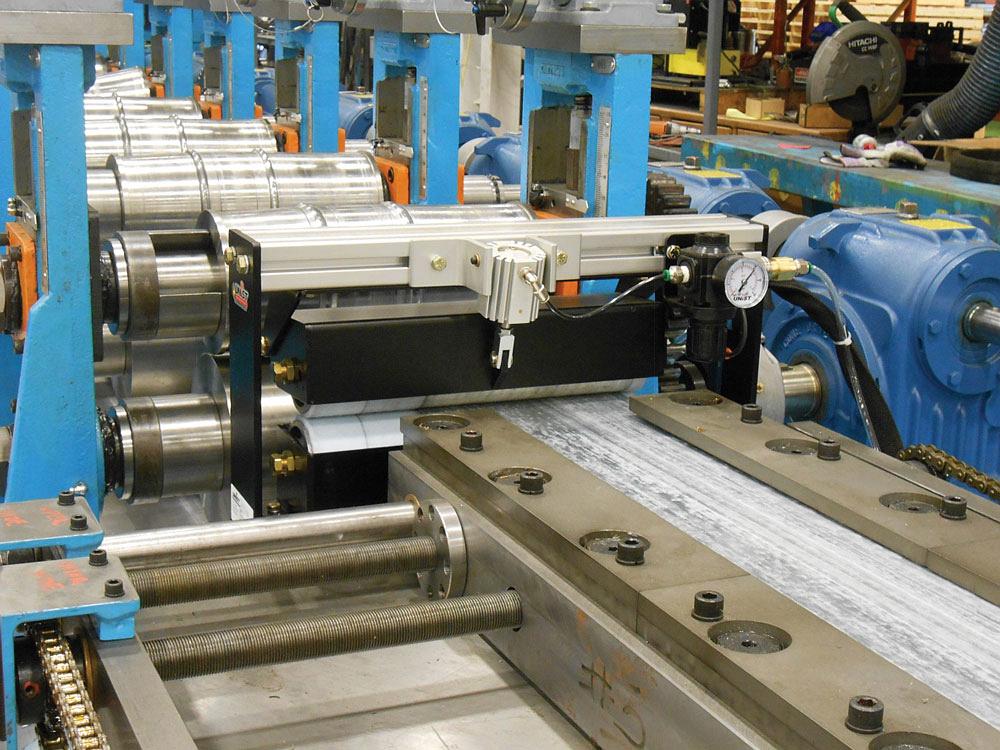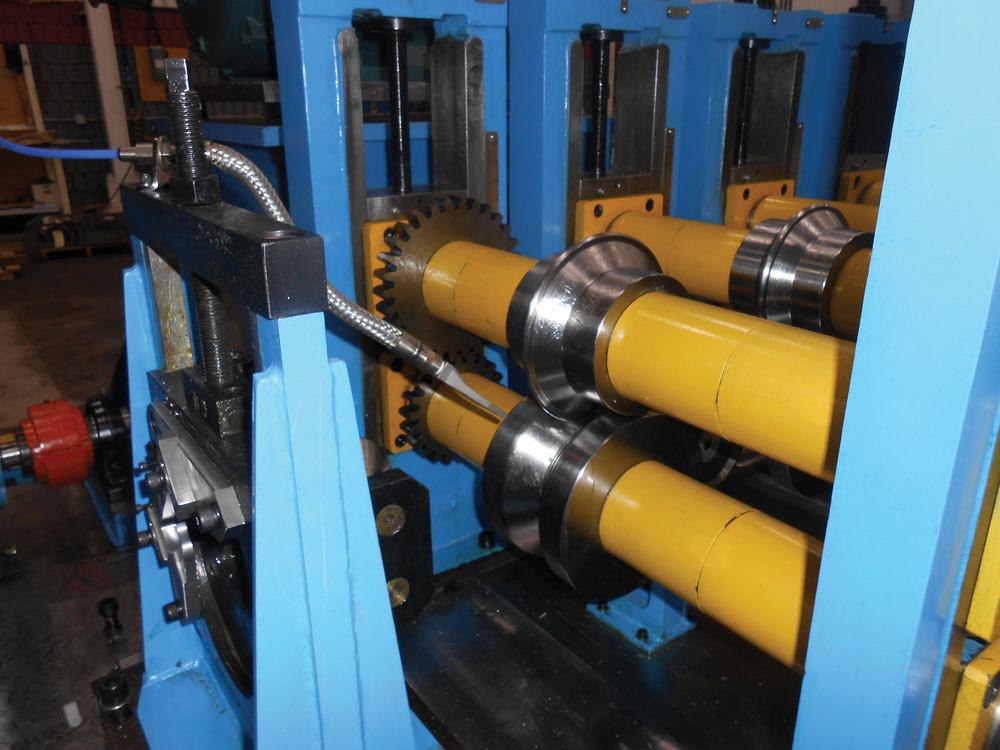2020/05/06 10:41 | Pageview:1393 | From: canadianmetalworking.com
Offering roll form tooling maintenance advice is complicated by the fact that each tooling set is designed for a
particular profile.  At the time a roll forming line is designed, the machine manufacturer considers what will be formed – what kind of shape will be made, the material it will be made from, the yield strength and elongation of the material, the total degrees of bends in the parts, and the tolerances that are to be applied to that part. They then consider whether the part will be precut or post-cut. These are some of the considerations used to select the tooling material.
At the time a roll forming line is designed, the machine manufacturer considers what will be formed – what kind of shape will be made, the material it will be made from, the yield strength and elongation of the material, the total degrees of bends in the parts, and the tolerances that are to be applied to that part. They then consider whether the part will be precut or post-cut. These are some of the considerations used to select the tooling material.
A careful consideration of the purpose and construction of your roll forming setup will determine the most critical maintenance points on your line.
Steel Basics
The tooling on a roll forming machine can be made of many types of tool steel, anything from 4140 to D2, depending on the part it is being used to produce. In addition to the base material the rolls will be made from, some of the tools could be heat-treated, an additional coating such as an ion nitride or chrome plating could be applied, and the roll might need to be highly polished. The treatment will depend on the material used for the part and what is expected of the finished product.
Understanding the materials used in making the rolls on your roll forming machine will help you better understand the critical components of your maintenance practices.
For instance, maintaining a tool that has been heat-treated is going to be different from maintaining one with no treatment applied to it. Some lower-end tooling is not hardened at all. But suppliers that make hardened tooling offer products that are hardened to between 58 and 62 Rockwell.
If you start polishing or reworking a roll that is not hardened, it is possible to remove some of the processes that were added to it or change the shape of the tool by polishing too hard. With a tool hardened to 62 Rockwell, you won’t do so. Be aware of how the tool was manufactured so you can be sure not to change its nature in the cleaning process.
Cleaning Fundamentals
A fundamental consideration for your roll forming line before you even start running it the first time is the environment in which it operates. Is it in a space where there is a risk of foreign particles getting into the line and interrupting the function of the rolls? If you run a roll-former in an environment with airborne particles that can get into its workings, those imperfections will be transferred to the material. They will show on your finished product. If you are running prepainted materials through your machine, these particles will damage that finish. Be sure you can keep the environment around the machine free from this form of contamination.
Sometimes, no matter how the environment is managed, the rolls still get dirty. If you are running Class A or prepainted materials through your roll former, any contamination can be considered a failure. In that case, it would be necessary to apply something to the machine that allows it to continually wipe away any contamination as the rolls keep turning. This is not an easy problem to solve, but working with your roll forming system supplier, it can be arranged.
And although this may sound obvious, when doing any maintenance on your roll forming line, the machine should be locked out and tagged out.

Pictured here is a coolant roller applicator system, which applies coolant directly to flat surfaces. Coolant management is a critical part of maintaining any roll forming setup.
Stress Points
Certain passes in your roll forming line work harder than the rest of the tooling, and that tooling will naturally wear out faster. If those passes aren’t managed proactively, the wear at that pass will affect every pass that follows. Be aware of which parts of your line include those passes and check these regularly.
Coating Management
If you are running prepainted material, it may be advisable to avoid using any kind of lubricant for cleaning. If a lubricant is used, it should be a vanishing oil or similar formulation that will evaporate without affecting the painted surface. The challenge in using a coolant with prepainted materials is that it could get trapped between stacked bundles and damage the surface of the parts.
Conversely, if you are running galvanized steel, it is necessary to use a coolant; if you don’t, the galvanizing material will begin to stick to the rolls. Once the galvanizing material starts sticking to the rolls, it is impossible to remove via a normal cleaning process; the roll has to be removed from the machine and taken to a machine shop to be polished off, recut, or replaced with a new roll.
If you are running black or hot-rolled steel with scaling on it, it is important to use coolant to increase the life of the tooling. A lot of the loose carbon particles will mix with the coolant/water mixture. This requires a filtration system for treatment, otherwise, those particles will be brought back to the tooling when the coolant is reused. It is possible to run hot-rolled or black steel without coolant, but the life of the tools will be shortened considerably.
Roll Position and Movement
It is important that rolls not touch each other. If material is pushed into a roll too forcefully, sometimes the roll at the top and bottom of the part can be knocked out of parallel and end up rubbing against each other when no part is being run through the machine. The rolls rubbing against each other can cause damage. Be sure to check that rolls remain or are put back into alignment during the maintenance process.

In this image and the first image in the article we see a coolant spray system. The benefit to using a spray system compared to a roller applicator is that it can supply coolant to any shape, size, or form.
Sometimes rolls don’t match the surface speed of the material. If this goes unchecked, the rolls can be scored by the material. To avoid this problem, it’s necessary to add lubricity to the tool or apply more coolant to the roll. The coolant has two purposes: It supplies lubricity, and as the process generates heat, it cools down the material. Without the use of coolant, a part can get so hot that its shape could change after the forming process is completed.
Tooling made for vertical passes where the speed cannot be matched is called free-running rolls. The purpose of these rolls is to contain the part on its path. They run freely but have bearings and bronze bushings in them that require regular lubrication. These should be checked for lubricity and to ensure no foreign objects lock up the bearings.
In some cases, side rolls are needed to keep materials in place to match the speed of the process. Rather than running horizontal, they run vertical or at a different angle to match the speed. Usually, side rolls have a different bracket and different bearings, and those have to be consistently greased.
Sensor Monitoring
It is now possible to equip your roll forming line with sensors to warn of potential future failures. These sensors monitor the heat levels registered in a bearing. If a sensor notices that the bearing is registering a temperature over a certain threshold, there is a problem. Either the bearing is worn out because it hasn’t been properly lubricated, it is running dry, or the tooling is creating a lot of force that wasn’t there before.
The point of the sensors is that they give you the ability to pinpoint where a problem might be. Some shops use a heat gun as an ad-hoc approach to the same problem, but it is much less precise than these sensor technologies. Like many other Industry 4.0 innovations, sensors are an important aspect of the next level of preventive maintenance practices.
Coolant Management
Coolant mix is very important. If you are using coolant that is mixed with water, be sure to follow the recommended dilution levels. If too much coolant oil is used, this will create problems with the part, either damaging any paint or finish on it or making it too slippery to properly travel through the roll forming line. Too much water could damage the machine. It gets in machine joints and stays there, and it may become impossible to remove the tooling from the shaft because of water damage.
Sometimes additives are added to coolants so that they don’t grow bacteria. Make sure that whatever additive is used won’t affect any other parts of the machine, such as seals, or finishes used on parts formed on the line.
Deburring
Tool life can also be shortened by the condition of the incoming steel. For instance, heavy burrs on the edge of material can prematurely damage rolls. Burrs can be removed by proper slitting of the material before it enters the machine or via a deburring process set up at the beginning of your line.
Initial Design Makes a Difference
This article began with a discussion of the distinctiveness of every roll form machine design. However, there are some roll tooling manufacturing standards that are important to keep in mind when you are having a line built. By following these standards, you can help your tooling last longer.
For instance, it might be possible to use a 4-in.-diameter tool to make a certain shape. However, roll form tooling manufacturing standards for that shape might recommend a 6-in.-diameter tool because each revolution will give you 18 in. instead of 12 in. of that shape and the life of the tool will be 1.5 times that of the 4-in.-diameter tool. Details like this and maintaining your coolant at an appropriate dilution level will save time and money in the long term.
